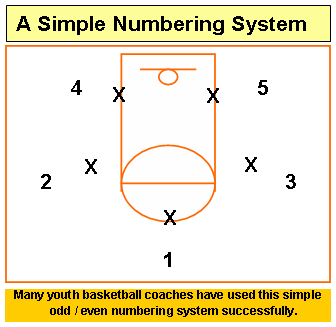Teaching Basketball Plays
(The 5 Most Important Steps)
The Offensive Play has basically one major purpose – it is designed to score points. If a play is executed properly, there should be lots of scoring opportunities. The offensive play is a “pattern” on the court that the players use to stay “organized” (for lack of a better word). If there were no plays, and the players just did whatever they wanted. This would cause “chaos” and players would be all over the place. From a coaches stand point, offensive plays are used to “counter” defenses that your opponents are running against your team.
Whether the coach calls a motion offense vs man to man defense, or a zone offense vs a zone defense – the main goal with teaching basketball plays is to ensure that the players are able to execute the plays. What does executing the plays mean? Finding open players, making good passes, setting proper screens, reading the defense, breaking down the defense, driving to the basket, and mainly – to run the offense until the best possible shot is taken. When players start passing the ball one time and jack up shots – it’s time for the coach to step in and settle things down.
A proven technique
I have put together what I feel are the 5 most important steps in teaching basketball plays to youth players. These steps are implemented after the coach has found 5 capable players (possible starters). Then you can begin the 5 step process described below. At any time if one of your so called “best players” cannot do their part with running a play correctly, it’s time for the coach to find one of the “right” players to take their spot. Remember you are not looking for the 5 “best” players – you are looking for the 5 “right” players to be your starters.
Teaching Basketball Plays, The 5 Important Steps Handout – CLICK HERE!
Here are my 5 main steps
(when teaching plays to youth players)
1. The Pattern: Each play should be a basic, continuous, pattern for the players to follow while on offense. Plays are needed so that there will be “structure” and “consistency” on the court. Plays should be a continuous pattern so that the players can run it to one side of the court, and if nothing develops there, be able to run the play to the other side of the court. The “pattern” should be easy to remember, but most importantly practiced over and over until the players are comfortable running it. I would suggest that coaches use some sort of “Numbering” system. Numbering systems is a very important part of teaching basketball plays. This helps the players remember where they are supposed to stand, makes it easier for coaches to sub players in and out, and helps players understand the plays better.
The Numbering System:

1 = Point Guard: The best ball handler on the team.
2 = Shooting Guard: Your best shooters position.
3 = Small Forward/Guard: Usually the player who loves to drive to the basket (and is able to do so).
4 = Forward: This player should be a hustler, and one of your fastest players.
5 = Center: The most aggressive rebounder, whether they are a small or a tall player (as long as they are tough and want to be on the court).
Note: For younger teams the Center position doesn’t necessarily have to be the tallest / largest player. A 5-guard set with this numbering system has proven to be very successful with younger teams. Coaches should try different combinations until they find what works and what doesn’t work for the team.
2. Responsibilities: Steps 1 and 2 usually go hand in hand and are taught simultaneously, I keep them separate to make sure to point out that the “responsibilities” part is very important and should not be overlooked. What is the responsibility of the Point Guard, Shooting Guard, Forward, and Center? Even if the play is trying to open up a shot for your shooter, all players have to “sell” the play or the play will be that much harder to execute. All players must do their part to help ensure the play will work. Players must understand that even if the “first” option is to the shooting guard, all players have to be ready at all times.
Every player is an option! Forwards and Centers should understand that if the shooter misses, they need to crash the boards and rebound (those are easy baskets for post players). Post players should think of “missed shots” as passes to them.
Teaching basketball plays Tip
When running any offensive play make sure that every pass is strong and accurate. Make sure that all players are ready for the pass (at all times).
3. The Options: Many coaches force the play to their best shooter and leave off all the other options available. I agree that each play should have a first option. But the main purpose of any play is to find the first available “easiest” shot! Every player should be an option on offense. This mentality works to the teams advantage – More options = More opportunities to score. Any offense that has lots of scoring options will keep a defense “guessing.” This is always a good thing.
Here’s how I teach the options – from the first pass, I tell the player to shoot, then I start the play over, and tell the player that they are not open and to look inside to the post player on the block (and have them pass the ball into the post for a shot). I then start over and from the first pass tell the player to drive, and also show the post player where to move to if the guard drives. Do this over and over until you have covered all the options of the offense. Next, point out to the players that the offense should not be rushed, look for all options, and make the defense work hard. Most importantly, we are looking for the first available “easy” shot.
Important Note:
Some problems that arise when running plays with youth basketball players is that you may have a few that every time they touch the ball they just want to “jack it up” and shoot every time they touch the ball. It is very hard to make younger players understand that the play is not a “one pass and shoot” offense. That there are certain players that you want to shoot. The most important part of basketball to youth players is shooting. All players want to shoot, but not all are going to be high percentage shooters.
4. Vs. a Defense (Scrimmaging): Now comes the hard part. The play always works great without any defense, but now you have to see what will happen with some defense. It’s time to put your second team out there to play some defense. The first thing I do is make it a “controlled” scrimmage (stop it and review options, responsibilities at will). This helps the players feel more comfortable with running the play. Once I feel the players are ready, we go full court and run a full scrimmage. I remind the players that this is practice so it’s ok to make mistakes, but they must work on fixing those mistakes.
Note: Scrimmages will tell a good story of how the players will do in “game like” situations. If you have a player that keeps making the same mistakes over and over, you may need to replace that player in the line up or move them to a different position. It is always a good thing to try different players in different line ups, etc.
5. Game Evaluation: It is one thing to play against your second string players, but now you have to see how the team will do against another team. Find teams to scrimmage as much as possible. You really don’t want to find out what works and what doesn’t during your “real” games. I usually discuss what I need to work on with the other coach so there are no problems during the scrimmage. One scrimmage I just showed up with my team, and the other coach just pressed the whole scrimmage. It was really early in the season and I did not have the team ready for this. After that my I always communicated with the other coaches so I knew what to expect – no more surprises.
This is a very important component of teaching basketball plays. Take plenty of notes, video taping the scrimmage is a must, and try different line ups.
Conclusion
There are many ways that coaches teach basketball plays. This is the one that I have used and have had success with. It may or may not work for all coaches. I just know that I have watched many coaches teach and realized that there are many “wrong” ways to do this. I have witnessed many coaches take 5 minutes to teach their team a play. Then yell at the players for not running it correctly during the games. The coach spends time yelling at the players for things that should have been taught correctly in the first place. If you have a very experienced team then you may be able to skip a couple steps. If your team doesn’t have a lot of experience – these 5 steps of teaching basketball plays will work just fine for you.
Take the time to “teach” the plays to your players, and you will notice improvements and success!
Check out our database of video clips – Example Motion Offense
Teaching Basketball Plays
Check out our New Downloads Now!
Check out our Station Drills Page Here


